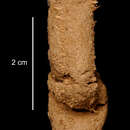fr
noms dans le fil d’Ariane


“ILYPHAGUS CORONATUS n.sp.
(Fig. 19.)
Sta. 29. 66° 28' S., 72° 41' E., off Princess Elizabeth Land, T M L, 1,266 m. (2).
Two specimens in poor condition, one of which is apparently complete. It measures 42 mm. by 7 mm. for about 18 chaetigers. I cannot make an exact count of the number of chaetigers. The body is flaccid and sac-like, and covered with a dense uniform fur of long, cirriform papillae coated with mud. There is a cephalic cage (fig. 19a) formed by the bristles of the first chaetiger, which may be about half as long as the body. They are all simple barred chaetae about 16 in number on each side of the head. The bristles of the second chaetiger are mostly broken off, but they are much longer than the normal body-bristles, point forward, and contribute to the cage. They are of the two types found in the feet throughout the body. The mouth is represented by a longitudinal slit, and on opening up the anterior end from the ventral surface there are revealed a pair of massive grooved palps and about ten stout, cylindrical branchiae.
The bristles come directly out of the body-wall through the covering of papillae, and when they are broken off near the base it is impossible without scraping off all the adjacent papillae to find their place of insertion, for there are no parapodial lobes.
The dorsal bristles (fig. 19b) are nearly all lost. They are slender barred capillary bristles similar to those described by me for I. hirsutus (Monro, 1937, 304, fig. 22a–c) from the Arabian Sea. The ventral bristles (fig. 19c), of which there are about seven in each foot, are shorter and stouter than the dorsal, obliquely striated, and end in long tapering tips. Towards the distal end many of them carry rows of stout hairs. They also are very like the ventral bristles of I. hirsutus. The body-papillae are long, cylindrical, and simple.
I have provisionally assigned this form to llyphagus, although all the species of this genus have been described as being without a cephalic cage, because in other respects the present specimens are closer to Ilyphagus than to any other genus. In fact except for the presence of the cephalic cage I see nothing to separate the present form from I. hirsutus. All the known examples of this genus have been dredged from great depths, and it seems to me quite possible that a cephalic cage may have been present in all of them, and broken off in the dredge. As I have already said, the long muddy papillae effectively conceal all traces of bristles if they are broken off short. I have looked for traces of a cephalic cage in my I. hirsutus, and failed to find them. However, until more material is forthcoming, the status of the three species of llyphagus described by Chamberlin and that of my I. hirsutus and the present form must remain doubtful.”
(Monro, 1939)
Ilyphagus coronatus is een borstelworm uit de familie Flabelligeridae. Het lichaam van de worm bestaat uit een kop, een cilindrisch, gesegmenteerd lichaam en een staartstukje. De kop bestaat uit een prostomium (gedeelte voor de mondopening) en een peristomium (gedeelte rond de mond) en draagt gepaarde aanhangsels (palpen, antennen en cirri).
Ilyphagus coronatus werd in 1939 voor het eerst wetenschappelijk beschreven door Monro.
Bronnen, noten en/of referenties